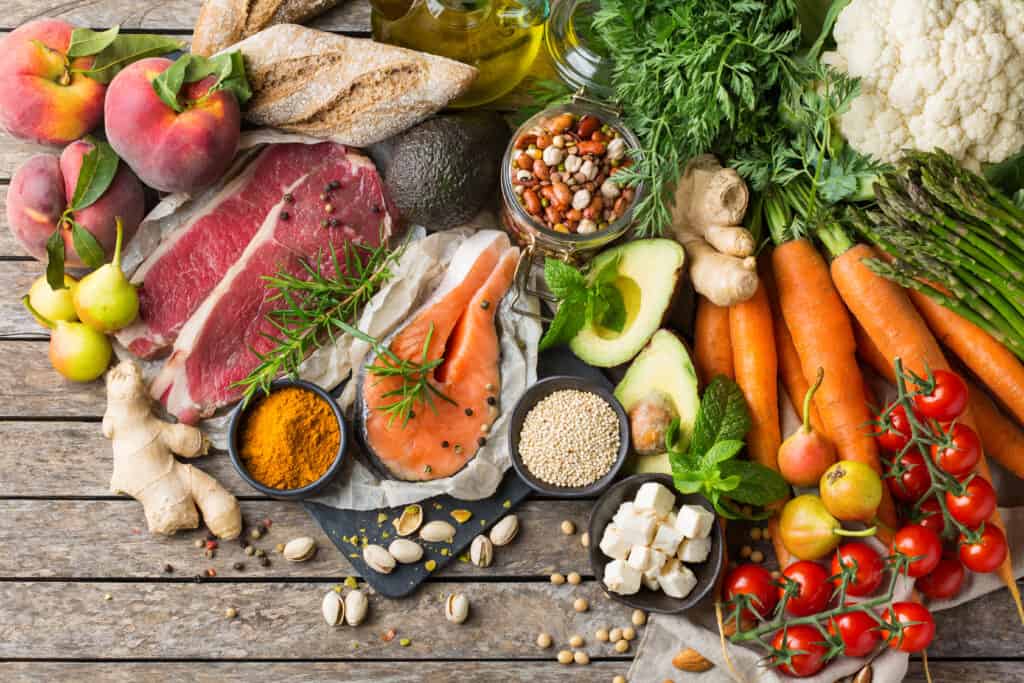Unlock the Secrets to Paleo Diet for Beginners
If you are looking for a diet that promotes weight loss and a healthy lifestyle, then the Paleo diet might be the perfect fit for you.
The Paleo diet, also known as the caveman diet, is a dietary plan based on the foods our ancestors ate during the Paleolithic era. This diet involves consuming whole, unprocessed foods while avoiding processed and refined foods, including grains, dairy, and legumes.
In this guide, we will explore why the Paleo diet is considered the ultimate weight loss solution.

What is the Paleo Diet?
The Paleo diet is based on the idea that our ancestors ate a diet that is more suitable for our bodies than the modern diet, which is full of processed and refined foods. During the Paleolithic era, humans were hunter-gatherers who consumed a diet that was primarily based on whole, unprocessed foods. The Paleo diet mimics this ancestral way of eating by emphasizing whole, nutrient-dense foods while eliminating processed and refined foods.
The Paleo diet involves consuming foods that can be hunted, fished, or gathered, such as meat, fish, poultry, vegetables, fruits, nuts, and seeds. It also involves avoiding foods that became prevalent after the advent of agriculture, including grains, dairy, and legumes. The idea behind this is that these foods are not as nutrient-dense and can be harder for our bodies to digest.
By following the Paleo diet, you are encouraged to eat foods that are rich in nutrients and essential vitamins and minerals. The focus is on consuming high-quality protein, healthy fats, and fiber-rich fruits and vegetables. This can help you feel full and satisfied while consuming fewer calories, which can ultimately lead to weight loss.
In addition to promoting weight loss, the Paleo diet has been linked to other health benefits, such as improved blood sugar control, reduced inflammation, and improved heart health. It may also help improve digestion and promote a healthy gut microbiome.
While the Paleo diet has gained popularity in recent years, it is not without its criticisms. Some experts argue that the diet is too restrictive and eliminates important food groups like dairy and grains, which can lead to nutrient deficiencies. It is important to note that the diet may not be suitable for everyone, especially those with certain medical conditions. As always, it is essential to consult with Dr. Nancie and Dr. Alphonso before starting any new diet or exercise program.
The Basics of the Paleo Diet
The Paleo diet is based on the premise that the human body is better adapted to the diet of our hunter-gatherer ancestors who roamed the earth millions of years ago. Our modern diet, which is high in processed and refined foods, is thought to be the root cause of many health problems, including obesity, type 2 diabetes, and heart disease.
The Paleo diet emphasizes whole, nutrient-dense foods while avoiding processed and refined foods that can cause inflammation in the body. By consuming whole foods, the diet aims to provide the body with the nutrients it needs to function at its best while reducing the risk of chronic diseases.
The diet focuses on consuming foods that can be hunted, fished, or gathered, such as meat, fish, poultry, vegetables, fruits, nuts, and seeds. These foods are rich in nutrients like protein, healthy fats, and fiber, which can help you feel full and satisfied while consuming fewer calories. By eliminating foods like grains, dairy, and legumes, the Paleo diet aims to reduce the risk of inflammation and promote a healthy gut microbiome.
The Paleo diet also encourages consuming organic, grass-fed, and pasture-raised foods whenever possible. This is because these types of foods are thought to be more nutrient-dense and free from harmful chemicals and additives.
In addition to consuming whole foods, the Paleo diet also encourages engaging in regular physical activity. This can help promote weight loss, maintain muscle mass, and improve overall health and well-being.
While the Paleo diet may seem restrictive to some, there are many delicious and nutritious foods that you can enjoy while following the diet. For example, you can enjoy meat, fish, poultry, vegetables, fruits, nuts, and seeds in a variety of different ways.
How the Paleo Diet Promotes Weight Loss
The Paleo diet is known for its ability to promote weight loss. This is because the diet emphasizes whole, nutrient-dense foods while avoiding processed and refined foods, which can contribute to weight gain.
One way the Paleo diet promotes weight loss is by being high in protein and fiber. Protein is essential for building and repairing muscles, and it also has a high thermic effect, meaning your body burns more calories digesting protein than it does digesting fat or carbohydrates. Consuming a diet high in protein can help you feel full and satisfied while consuming fewer calories, which can lead to weight loss.
Fiber, on the other hand, helps regulate blood sugar levels and promotes feelings of fullness. High-fiber foods take longer to digest, which means they can help you feel full for longer periods and prevent overeating. By consuming a diet high in fiber, you can reduce the number of calories you consume each day, which can ultimately lead to weight loss.
Another way the Paleo diet promotes weight loss is by being low in carbohydrates, particularly refined carbohydrates like bread, pasta, and pastries. Consuming a diet low in carbohydrates can help you lose weight by reducing insulin levels, which promotes fat burning. By avoiding refined carbohydrates and focusing on whole, nutrient-dense foods, you can reduce your carbohydrate intake while still providing your body with the nutrients it needs to function at its best.
The Paleo diet is also high in healthy fats from sources like avocado, nuts, and seeds. Consuming healthy fats can help you feel full and satisfied, which can prevent overeating. It can also promote fat burning and help you maintain lean muscle mass.
Furthermore, the Paleo diet eliminates processed and refined foods, which are often high in sugar, sodium, and unhealthy fats. Consuming these types of foods can lead to overeating and weight gain. By eliminating these foods and focusing on whole, nutrient-dense foods, you can reduce your calorie intake and promote weight loss.
High in Protein and Fiber
Protein is a crucial component of the Paleo diet. It is an essential nutrient that helps build and repair muscle tissue, and it plays a key role in many bodily functions. By consuming a diet high in protein, you can help maintain lean muscle mass while promoting weight loss.
One of the reasons why the Paleo diet is high in protein is that it includes a variety of animal-based foods like meat, fish, and poultry. These foods are naturally high in protein and are also rich in other nutrients like iron, zinc, and vitamin B12.

In addition to animal-based foods, the Paleo diet also includes plant-based sources of protein like nuts, seeds, and legumes. While legumes are typically avoided on the Paleo diet, nuts and seeds can provide a significant amount of protein while also being rich in healthy fats and fiber.
Fiber is another essential component of the Paleo diet. It is a type of carbohydrate that is not digested by the body, meaning it does not contribute to calorie intake. Instead, fiber helps regulate blood sugar levels and promotes feelings of fullness.
By consuming a diet high in fiber, you can help reduce the number of calories you consume each day while also promoting digestive health. High-fiber foods like fruits, vegetables, nuts, and seeds take longer to digest, which means they can help you feel full for longer periods and prevent overeating.
Low in Carbohydrates
Carbohydrates are an important source of energy for the body, but not all carbohydrates are created equal. Refined carbohydrates, such as bread, pasta, and pastries, can cause spikes in blood sugar levels and can contribute to weight gain.
The Paleo diet is low in carbohydrates, particularly refined carbohydrates, and instead focuses on consuming whole, nutrient-dense foods like meat, fish, poultry, vegetables, fruits, nuts, and seeds. By reducing carbohydrate intake, the body is forced to use fat as a source of energy, which can promote fat burning and ultimately lead to weight loss.
Reducing carbohydrate intake can also help regulate insulin levels. Insulin is a hormone that regulates blood sugar levels, and high levels of insulin can promote fat storage. By reducing carbohydrate intake, the body produces less insulin, which promotes fat burning and can lead to weight loss.
The Paleo diet does not completely eliminate carbohydrates but instead focuses on consuming complex carbohydrates from sources like vegetables and fruits. These foods are high in fiber, which helps regulate blood sugar levels and promotes feelings of fullness.
It is important to note that reducing carbohydrate intake may not be suitable for everyone, especially those with certain medical conditions. It is essential to consult with Dr. Nancie and Dr. Alphonso before making any significant changes to your diet.
High in Healthy Fats
Contrary to popular belief, consuming healthy fats can actually promote weight loss and overall health. The Paleo diet is high in healthy fats from sources like avocado, nuts, and seeds, which can provide the body with essential nutrients while also promoting satiety and weight loss.
Healthy fats are an important component of a balanced diet because they provide the body with essential fatty acids that cannot be produced by the body. They also help the body absorb important fat-soluble vitamins like vitamin A, D, E, and K.

Healthy fats can also help regulate blood sugar levels, which can prevent overeating and promote weight loss. This is because they are digested more slowly than carbohydrates and protein, which means they can help you feel full and satisfied for longer periods.
In addition, consuming healthy fats can promote fat burning and help maintain lean muscle mass. This is because they provide the body with a source of energy that can be used during exercise and physical activity.
The Paleo diet includes a variety of healthy fats from sources like avocado, nuts, and seeds. These foods are also rich in other nutrients like fiber, protein, and vitamins, which makes them a nutritious addition to any diet.
It is important to note that not all fats are created equal, and it is important to focus on consuming healthy fats rather than unhealthy fats from sources like fried foods, processed snacks, and sugary treats.
Eliminates Processed and Refined Foods
Processed and refined foods have become a staple in the modern diet, but they can be detrimental to our health and contribute to weight gain. The Paleo diet eliminates these types of foods and instead focuses on consuming whole, nutrient-dense foods.
Processed and refined foods are often high in sugar, sodium, and unhealthy fats, which can contribute to inflammation in the body and promote weight gain. These types of foods also lack essential nutrients like fiber, vitamins, and minerals, which can lead to nutrient deficiencies and other health problems.
By eliminating processed and refined foods, the Paleo diet encourages the consumption of whole, nutrient-dense foods that are rich in essential nutrients. This can help reduce inflammation in the body and promote overall health and well-being.
Furthermore, processed and refined foods can be addictive, which can lead to overeating and weight gain. These foods are often engineered to be highly palatable, making them difficult to resist. By eliminating these types of foods, the Paleo diet can help break the cycle of addiction and promote healthier eating habits.
Encourages Whole, Unprocessed Foods
The Paleo diet emphasizes the consumption of whole, unprocessed foods, which are typically nutrient-dense and low in calories. These foods are often rich in vitamins, minerals, and other essential nutrients that can help the body function at its best.
Whole, unprocessed foods are also typically low in calories, which can promote weight loss by reducing calorie intake. These foods are often rich in fiber, which helps regulate blood sugar levels and promotes feelings of fullness. By consuming whole, unprocessed foods, you can reduce the number of calories you consume each day without sacrificing essential nutrients.
In addition to promoting weight loss, consuming whole, unprocessed foods can also reduce the risk of chronic diseases like type 2 diabetes, heart disease, and certain types of cancer. This is because these types of foods are often rich in antioxidants and other compounds that can protect the body against oxidative stress and inflammation.
Examples of whole, unprocessed foods that are encouraged on the Paleo diet include meat, fish, poultry, vegetables, fruits, nuts, and seeds. These foods are often consumed in their natural form, without any added sugars, fats, or preservatives.
By emphasizing the consumption of whole, unprocessed foods, the Paleo diet provides the body with the essential nutrients it needs to function at its best while promoting weight loss and overall health and well-being.
How to Get Started on the Paleo Diet
If you are interested in trying the Paleo diet, here are some tips to help you get started:
- Educate yourself: Before starting any new diet, it is important to educate yourself on the principles and guidelines. The Paleo diet involves consuming whole, unprocessed foods while avoiding processed and refined foods. Take some time to research the diet and familiarize yourself with the types of foods that are encouraged and discouraged.
- Plan your meals: Planning your meals ahead of time can help ensure that you are consuming a balanced diet that meets your nutritional needs. Look for Paleo-friendly recipes and meal ideas to help you get started.
- Stock up on Paleo-friendly foods: Once you have a good understanding of the types of foods that are encouraged on the Paleo diet, it’s time to stock up on these foods. Look for fresh, whole foods like meat, fish, poultry, vegetables, fruits, nuts, and seeds.
- Make gradual changes: It can be challenging to make significant changes to your diet overnight. Instead, try making gradual changes over time. Start by eliminating processed and refined foods and gradually incorporating more whole, nutrient-dense foods into your diet.
- Don’t be too hard on yourself: Changing your diet can be challenging, and it’s important to remember that it’s okay to slip up from time to time. Instead of feeling guilty, focus on making healthier choices moving forward.
- Seek support: If you are struggling to make the transition to the Paleo diet, seek support from friends, family, or Dr. Nancie and Dr. Alphonso. They can provide encouragement and support as you make changes to your diet.
Overall, getting started on the Paleo diet involves educating yourself on the principles and guidelines, planning your meals, stocking up on Paleo-friendly foods, making gradual changes, and seeking support when needed. With time and effort, the Paleo diet can be an effective weight loss solution while also promoting overall health and well-being.
Eliminate Processed and Refined Foods
Eliminating processed and refined foods from your diet is a crucial step in getting started on the Paleo diet. These types of foods are often high in sugar, sodium, and unhealthy fats, which can contribute to inflammation, weight gain, and other health problems.
To get started on the Paleo diet, start by eliminating grains, dairy, and legumes from your diet. These foods became prevalent after the advent of agriculture and are therefore not consumed on the Paleo diet. Instead, focus on consuming whole, unprocessed foods like meat, fish, poultry, vegetables, fruits, nuts, and seeds.
When shopping for food, look for fresh, whole foods that are minimally processed. Avoid foods that contain added sugars, preservatives, or other artificial ingredients. Try to stick to the perimeter of the grocery store, where you’ll find fresh produce, meat, and dairy alternatives like almond milk or coconut yogurt.
As you transition to the Paleo diet, you may experience some initial challenges, such as cravings or hunger. This is normal and can be managed by eating nutrient-dense foods that are rich in protein and healthy fats. It’s also important to stay hydrated and get plenty of sleep to support your body’s transition to the new diet.
Plan Your Meals
Planning your meals is an essential part of getting started on the Paleo diet. This can help ensure that you are consuming a balanced and nutritious diet that meets your nutritional needs. Here are some tips to help you plan your meals on the Paleo diet:
- Make a list of Paleo-friendly foods: Start by making a list of foods that are encouraged on the Paleo diet, including meat, fish, poultry, vegetables, fruits, nuts, and seeds. Use this list as a reference when planning your meals.
- Plan your meals ahead of time: Set aside some time each week to plan your meals ahead of time. This can help you save time and reduce stress during the week. Look for Paleo-friendly recipes or meal ideas to help you get started.
- Balance your macronutrients: The Paleo diet emphasizes consuming protein and healthy fats while limiting carbohydrates. Make sure your meals include a balance of these macronutrients to ensure that you are meeting your nutritional needs.
- Prepare meals in advance: Consider preparing some of your meals in advance to save time during the week. You can batch cook meals and store them in the fridge or freezer for later use.
- Don’t forget about snacks: Snacks can be an important part of your meal plan, especially if you have a busy schedule. Look for Paleo-friendly snacks like fresh fruit, nuts, and seeds to help keep you fueled throughout the day.
- Be flexible: Remember that it’s okay to be flexible with your meal plan. If you don’t feel like cooking one night, don’t be afraid to switch things up and have a salad or smoothie instead.
Overall, planning your meals is an important part of getting started on the Paleo diet. By making a list of Paleo-friendly foods, planning your meals ahead of time, balancing your macronutrients, preparing meals in advance, and being flexible, you can ensure that you are consuming a balanced and nutritious diet that promotes weight loss and overall health and well-being.
Stock Your Kitchen with Paleo-Friendly Foods
To successfully follow the Paleo diet, it’s important to stock your kitchen with Paleo-friendly foods. Here are some tips to help you stock your kitchen with the right foods:
- Make a list: Before heading to the grocery store, make a list of Paleo-friendly foods that you want to stock up on. Include whole foods like meat, fish, poultry, vegetables, fruits, nuts, and seeds.
- Shop the perimeter: When shopping for food, try to stick to the perimeter of the grocery store. This is where you’ll find fresh produce, meat, and dairy alternatives like almond milk or coconut yogurt.
- Choose organic and grass-fed: When possible, choose organic and grass-fed meats and dairy products. These foods are often more nutritious and have a better balance of healthy fats.
- Avoid processed and packaged foods: Avoid processed and packaged foods, which are often high in sugar, sodium, and unhealthy fats. Stick to whole, nutrient-dense foods.
- Experiment with new foods: The Paleo diet can introduce you to new foods and flavors that you may not have tried before. Experiment with new foods and recipes to keep things interesting.
- Keep healthy snacks on hand: Stock up on healthy snacks like fresh fruit, nuts, and seeds. This can help you stay satisfied between meals and prevent unhealthy snacking.
By stocking your kitchen with Paleo-friendly foods, you’ll be better prepared to follow the diet and meet your nutritional needs. By choosing whole, nutrient-dense foods and avoiding processed and packaged foods, you’ll be providing your body with the essential nutrients it needs to function at its best while promoting weight loss and overall health and well-being.
Experiment with New Recipes
Following the Paleo diet doesn’t have to be boring or repetitive. In fact, experimenting with new recipes can help keep your meals interesting and prevent boredom. Here are some tips to help you experiment with new recipes on the Paleo diet:
- Look for Paleo-friendly recipes: Look for recipes that are specifically designed for the Paleo diet. There are many online resources, cookbooks, and blogs that offer a wide variety of Paleo-friendly recipes.
- Try new ingredients: The Paleo diet encourages consuming whole, unprocessed foods, which can introduce you to new ingredients and flavors. Try incorporating new ingredients like coconut oil, almond flour, or coconut milk into your recipes.
- Adapt traditional recipes: Many traditional recipes can be adapted to fit the Paleo diet. For example, you can replace pasta with zucchini noodles or cauliflower rice, or use almond flour instead of wheat flour.
- Meal prep: Meal prepping can help save time and make it easier to try new recipes. Set aside some time each week to plan and prepare your meals in advance.
- Get creative: Don’t be afraid to get creative in the kitchen. Try experimenting with different flavor combinations and spices to add variety to your meals.
By experimenting with new recipes, you can keep your meals interesting and enjoyable while still following the principles of the Paleo diet. Remember to choose whole, unprocessed ingredients and focus on balancing your macronutrients to ensure that your meals are both delicious and nutritious.
Listen to Your Body
While the Paleo diet can be an effective weight loss solution, it’s important to listen to your body and make adjustments as necessary. Here are some tips to help you listen to your body on the Paleo diet:
- Pay attention to hunger cues: It’s important to pay attention to your body’s hunger cues and eat when you’re hungry. Don’t skip meals or restrict calories too much, as this can lead to overeating later on.
- Add more protein or healthy fats: If you’re feeling hungry or unsatisfied, try adding more protein or healthy fats to your diet. These macronutrients can help keep you full and satisfied between meals.
- Stay hydrated: Drinking enough water is essential for overall health and well-being. It can also help you feel full and prevent overeating. Make sure to drink plenty of water throughout the day.
- Get enough sleep: Getting enough sleep is important for maintaining a healthy weight and promoting overall health. Aim for 7-8 hours of sleep each night to support your body’s natural processes.
- Don’t be too strict: Remember that it’s okay to be flexible with your diet. Don’t be too strict with yourself, and allow yourself to enjoy the occasional indulgence or treat.
By listening to your body and making adjustments as necessary, you can ensure that you are consuming a balanced and nutritious diet that promotes weight loss and overall health and well-being.
Stay Active
While the Paleo diet can be a great way to promote weight loss, it’s important to combine it with regular physical activity. Here are some tips to help you stay active on the Paleo diet:
- Find an activity you enjoy: Engaging in physical activity doesn’t have to be a chore. Find an activity that you enjoy, whether it’s walking, running, weightlifting, or yoga. This can make it easier to stick to a regular exercise routine.
- Incorporate strength training: Strength training is an important part of maintaining muscle mass and promoting weight loss. Incorporate weightlifting or resistance training into your exercise routine to help build and maintain muscle.
- Make it a habit: Make exercise a regular habit by scheduling it into your day. Set aside time each day for physical activity, whether it’s a morning walk or an evening yoga class.
- Stay active throughout the day: In addition to formal exercise, find ways to stay active throughout the day. Take the stairs instead of the elevator, park farther away from the store, or take a walk during your lunch break.
- Be consistent: Consistency is key when it comes to physical activity. Aim for at least 30 minutes of moderate-intensity exercise each day to promote weight loss and overall health.
By staying active on the Paleo diet, you can help maintain muscle mass, promote weight loss, and support overall health and well-being. Remember to find activities that you enjoy, incorporate strength training, make exercise a habit, stay active throughout the day, and be consistent with your routine.
Frequently Asked Questions
- Is the Paleo diet suitable for everyone?
While the Paleo diet can be an effective weight loss solution, it may not be suitable for everyone, especially those with certain medical conditions. It is essential to consult with Dr. Nancie and Dr. Alphonso before starting any new diet.
- Can I still enjoy dessert on the Paleo diet?
Yes, there are many Paleo-friendly dessert options, such as coconut flour brownies or fruit salad with coconut whipped cream.
- Can I eat dairy on the Paleo diet?
No, dairy is not allowed on the Paleo diet. However, there are many Paleo-friendly alternatives to dairy, such as coconut milk or almond milk.
- Can I eat grains on the Paleo diet?
No, grains are not allowed on the Paleo diet. However, there are many Paleo-friendly alternatives to grains, such as cauliflower rice or zucchini noodles.
- How long does it take to see weight loss results on the Paleo diet?
Weight loss results may vary depending on the individual, but many people report seeing results within the first few weeks of starting the Paleo diet.
Start Your Paleo Diet Journey Today
The Paleo diet can be an effective weight loss solution due to its emphasis on whole, unprocessed foods and its low-carbohydrate, high-protein, and high-fiber content. By eliminating processed and refined foods from your diet and focusing on consuming nutrient-dense whole foods, you can achieve your weight loss goals and promote a healthy lifestyle.
Remember to listen to your body and consult with Dr. Nancie and Dr. Alphonso before starting any new diet or exercise program.
What To Do Next…
For people who want to stop struggling with their weight

We Now Have FDA Approved Semaglutide Weight Loss in Sarasota and Bradenton Florida. Book a free consultation and find out about the semaglutide cost and semaglutide side effects. Semaglutide injection are available after your free consultation.






